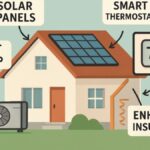With energy costs on the rise and environmental concerns at the forefront, today’s homeowners are seeking more efficient ways to control their indoor climate. Focusing on smart technology, renewable integration, and building enhancements, efficient heating and cooling solutions can contribute significantly to both comfort and cost savings. Whether you’re considering an upgrade or building new, the latest advancements—including the ability to shop for AC heat pumps online—make finding a tailored solution easier than ever.
Balancing thermal comfort with eco-conscious decision-making is more achievable now due to a range of modern HVAC technologies and strategies. Adopting efficient systems means less wasted energy, lower monthly bills, and a reduced environmental footprint, all while keeping your home comfortable across all seasons.
Understanding Energy Efficiency in HVAC Systems
Energy efficiency in heating, ventilation, and air conditioning (HVAC) systems measures the amount of energy required to maintain consistent indoor temperatures. The most efficient systems utilize cutting-edge components and controls, enabling better performance while using less power. Well-chosen solutions not only curb energy waste but also support global efforts to cut carbon emissions. For example, ENERGY STAR-certified products can use up to 20% less energy than standard models, according to the U.S. Department of Energy.
Advancements in Heat Pump Technology
Heat pumps lead the way in transitioning away from older, energy-intensive heating systems. They function by moving heat instead of generating it, making them more efficient and eco-friendly. Today’s models, including those designed for colder climates, utilize improved refrigerants and compressors for consistent heating and cooling—even when outdoor temperatures drop below freezing. These innovations enable heat pumps to deliver significant savings and comfort in regions where traditional pumps previously struggled. According to the U.S. Department of Energy, high-efficiency heat pumps can reduce annual heating electricity use by up to 50% compared to electric furnaces or baseboard heaters.
Smart Thermostats: Enhancing Control and Efficiency
Smart thermostats have changed how homeowners manage energy use and temperature comfort. These devices automatically learn household routines, adjust settings to match occupancy patterns, and can be controlled via smartphone or voice assistant. As a result, energy is never wasted on empty rooms or unneeded heating and cooling cycles. Features such as usage insights, real-time alerts, and geofencing ensure that HVAC systems run only when needed—optimizing savings without sacrificing comfort.
Importance of Proper Insulation
Comprehensive, well-installed insulation remains one of the most cost-effective ways to improve home efficiency. Insulation reduces unwanted heat transfer, allowing for longer maintenance of desired indoor temperatures and a reduced HVAC workload. From attic blow-in materials to weather-stripping on windows and doors, each layer plays a part. Energy experts recommend focusing on attics and walls, as these are the most common sources of heat loss or gain. Enhanced windows, including double- or triple-pane options, further limit drafts and contribute to year-round comfort.
Regular Maintenance for Optimal Performance
Routine inspection and maintenance are essential for ensuring heating and cooling systems operate at peak efficiency. Simple tasks, such as regularly replacing air filters, help maintain clean airflow, reduce strain on the system, and improve indoor air quality. Checking for leaks in ductwork or refrigerant lines prevents energy loss and potential damage, while calibrating thermostats ensures accurate temperature control and comfort. Lubricating moving parts minimizes wear and tear, thereby reducing the risk of mechanical failure and extending the equipment’s lifespan. Beyond these routine steps, scheduling annual professional maintenance, as recommended by Consumer Reports, provides a thorough evaluation of system components, identifies hidden issues, and helps prevent unexpected, costly repairs. Consistent upkeep ultimately leads to lower energy bills, enhanced performance, and reliable year-round comfort.
Exploring Renewable Energy Integration
An increasing number of homeowners are exploring ways to integrate their HVAC systems with renewable energy solutions, particularly solar power, to create more sustainable and cost-effective homes. Solar panels can convert sunlight into electricity that partially or fully powers heating, cooling, and other household energy needs, significantly reducing reliance on conventional energy sources. With the declining costs of solar panel installation and a variety of incentives, tax credits, and rebates available in many regions, adopting solar-powered HVAC systems has become both practical and financially appealing. Over time, these systems can lead to substantial savings on energy bills while also contributing to environmental sustainability. Additionally, combining solar energy with modern HVAC technology enhances energy efficiency, increases home value, and positions homeowners to benefit from long-term clean energy solutions.
Considering Geothermal Systems
Geothermal heating and cooling systems harness the earth’s stable underground temperature using a buried loop system. The constant temperature below the surface enables these systems to efficiently transfer heat into or out of the home throughout the year—offering up to 70% lower consumption than conventional systems. Geothermal installations require a higher upfront investment but provide exceptionally low operational costs, minimal maintenance, and a long system lifespan. Many experts now rank geothermal among the best long-term investments for sustainable comfort.
Conclusion
Modern heating and cooling solutions offer homeowners the opportunity to enjoy consistent, year-round comfort while significantly reducing energy consumption and utility costs. Innovations such as energy-efficient heat pumps, smart thermostats, and advanced insulation materials allow homes to maintain optimal temperatures with minimal waste. Incorporating renewable energy sources, such as solar-assisted systems, further enhances sustainability and reduces reliance on traditional power grids. Selecting the right system tailored to your home’s size, climate, and lifestyle ensures maximum efficiency, while regular maintenance ensures the equipment performs optimally. Beyond cost savings, these upgrades contribute to a smaller carbon footprint, promoting environmental responsibility. By combining smart technology, proactive care, and sustainable practices, homeowners can enjoy long-term comfort, efficiency, and eco-friendly living without compromising convenience or reliability.






